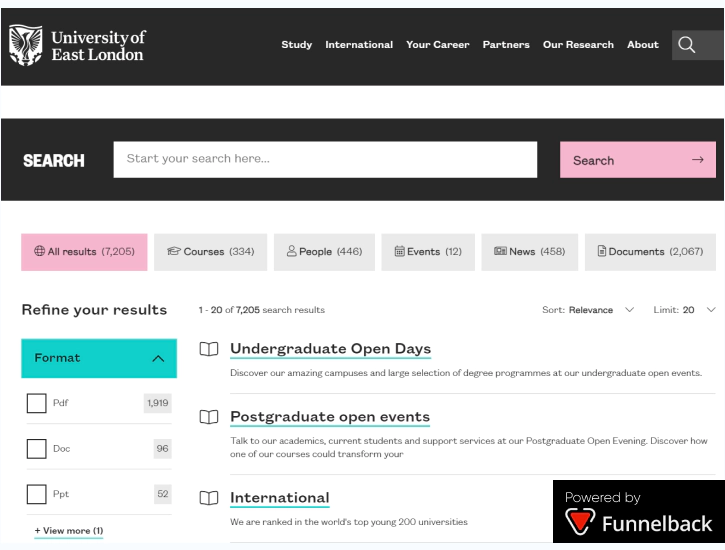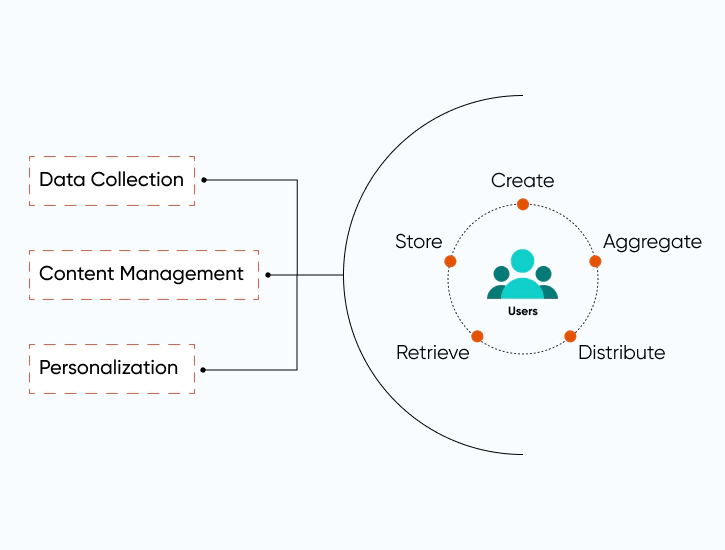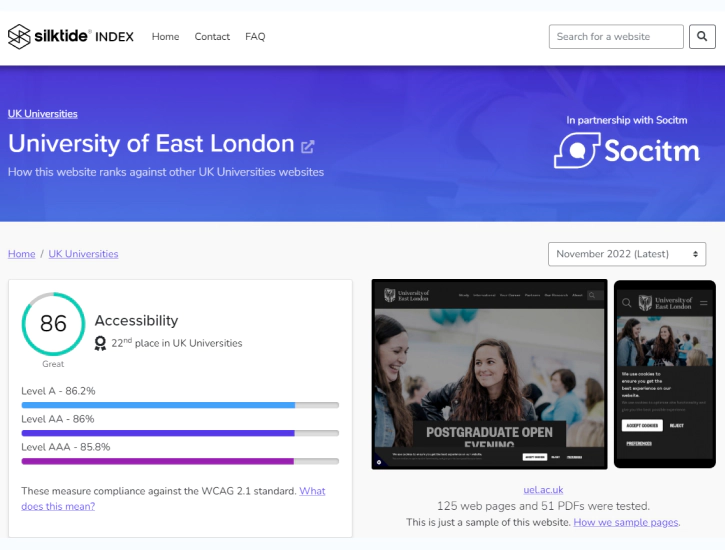Re-engineering the University of East London’s DXP: From Sitecore to Drupal
The University of East London (UEL) is a dynamic, future-focused institution with a global student community across more than 150 countries. Yet, its digital ecosystem didn’t reflect the innovation, inclusivity, and ambition the university stood for.
Multiple legacy systems, outdated design frameworks, and fragmented content delivery were creating friction in the student and stakeholder experience.From prospective students to researchers and alumni, the website failed to guide different user groups seamlessly through their journeys.
UEL engaged Axelerant to reimagine its entire digital experience — not as a collection of pages, but as a data-driven, experience-led platform (DXP) designed to engage, measure, and convert across audiences.
About the Customer
Founded in 1898, University of East London (UEL) is a public university located in the London Borough of Newham, London, England. It is ranked in the world’s top 250 young universities.
UEL is a careers-first university, giving people from all walks of life access to education and industry. It focuses on developing skills, emotional intelligence, and creativity needed to thrive in a changing world.
The university’s vision is to advance knowledge and drive innovation for positive change for people and the planet. It aims to prepare students for the jobs of the future, and provide the innovation to drive that future sustainably and inclusivity by 2028.
- 125
Years of Pioneering Futures
- 156
Nations to which UEL's Students Belong
- #1
In the UK for Addressing Inequalities
- 250
Rank in World's Top Young University

The Challenge
The university’s digital presence was content-rich but context-poor. Information was available, but not accessible. Prospective students couldn’t easily discover courses, researchers couldn’t amplify their work, and the brand’s digital identity lacked clarity and responsiveness.
The key challenges included:
- Disconnected digital touchpoints across admissions, research, and student services.
- Lack of personalization or dynamic content delivery for different audience segments.
- Manual workflows for course and funding updates, creating inefficiencies.
- Limited data-driven decision-making — marketing and content teams lacked unified analytics and behavioral insights.
- Accessibility shortfalls that fell below UEL’s inclusivity goals.
The objective was clear: transform UEL’s website into a composable DXP that connects experience, data, and activation — creating a platform as forward-thinking as the university itself.

The Solution
Axelerant’s approach began with qualitative research, user journey mapping, and stakeholder co-creation, evolving into a fully integrated digital experience platform architecture and conversion strategy.The engagement spanned experience design, data engineering, automation, and continuous measurement.
Qualitative Research and Journey Mapping — Understanding Human Context
We began with deep-dive research across UEL’s core audiences:
prospective students, current students, researchers, alumni, and faculty.
Through interviews, surveys, and analytics audits, we identified pain points and motivational drivers across key digital journeys:
- Prospective Students: Needed clear, emotionally engaging course discovery experiences — from aspiration to application.
- Researchers: Wanted better visibility for publications and collaborations.
- Current Students: Sought immediate access to academic and campus resources.
- Parents and Counselors: Needed clarity on funding, career outcomes, and university reputation.
Journey mapping revealed that users were dropping off between research and decision stages — overwhelmed by static, text-heavy pages and lack of guided pathways.
This insight became foundational:
Every audience needed a digital experience that not only informs but guides, reassures, and converts.
Experience Strategy — Designing for Clarity and Confidence
The design strategy centered on Digital Simplicity and Academic Confidence.
We redefined UEL’s digital experience through three guiding principles:
1. Purposeful Navigation: Simplified pathways to help users find relevant courses, research, or stories within two clicks.
2. Emotional Visual Language: Modern, inclusive imagery and clear typography conveying academic credibility without intimidation.
3. Progressive Disclosure: Contextual layering of information — showing users just enough to act, then offering depth for exploration.
The interface was not just redesigned; it was re-sequenced around journeys.
Students could now move fluidly from program discovery to funding details to application readiness, while researchers and partners found a narrative of innovation and collaboration.
Accessibility exceeded WCAG 2.1 AA standards — achieving AAA compliance in critical sections to reinforce UEL’s inclusivity commitment.
DXP Architecture — Integrating Experience, Data, and Activation
To deliver consistent, data-informed, and agile experiences, Axelerant built a Composable Digital Experience Platform (DXP) powered by Drupal at its core.
This architecture unified content, data, and marketing automation within a single intelligent layer.
Key elements included:
- Unified Data Layer: Combined analytics, CRM, and form data for 360° audience visibility.
- Content-as-a-Service (CaaS): Modular content blocks reused across course pages, blogs, and campaign landing pages for consistency and speed.
- Automation Frameworks: Automated updates for course data, fees, funding, and application deadlines — reducing manual maintenance.
- Integration Layer: Connected CRM (student inquiry data), analytics (behavioral tracking), and marketing automation tools (email journeys, re-engagement triggers).
- Performance Infrastructure: Delivered enterprise-grade speed, security, and scalability for global audiences.
The result was a dynamic digital ecosystem that merged storytelling and system intelligence — powering UEL’s evolution from a static site to a responsive, data-aware experience hub.
Activation and Conversion Strategy — From Awareness to Application
Once the experience and data layers were unified, we developed a conversion strategy anchored in measurable outcomes — from lead generation to content performance.
The focus shifted from page views to journey success:
- Conversion Path Optimization: Streamlined course exploration and inquiry journeys — reducing click depth and friction.
- Micro-Conversion Mapping: Measured engagement with key signals such as course brochure downloads, open day registrations, and inquiry form completions.
- Personalization Logic: Introduced dynamic CTAs based on user behavior — e.g., returning visitors saw “Continue Your Application” instead of “Learn More.”
- Automated Nurture Journeys: Connected form submissions to marketing automation workflows, triggering relevant content and advisor follow-ups.
- Real-Time Analytics Dashboards: Visualized KPIs — from course interest to inquiry conversion — for continuous optimization.
Conversion was now a living feedback system, not a static metric — enabling marketing teams to experiment, learn, and refine continuously.

The Result
The new UEL digital experience was more than a website — it became a conversion-oriented experience platform uniting creativity, data, and automation.
Key Achievements:
- 73% increase in student applications and 32% increase in enrollments were achieved within two years, along with a 10–14% average rise in engagement across course offerings.
- 4% click-through rate for geo-targeted personalization and a 46% reduction in user exits indicate improved retention and success through targeted personalization strategies.
- 99.9% website uptime ensures consistent access and improved performance for users and administrators alike.
- 90% WCAG 2.1 AA compliance demonstrates strong progress toward global accessibility standards, ensuring the platform is inclusive and usable for all users.
- Significant increase in new user acquisition and engagement through structured content campaigns.
- Improved conversion rates on course inquiry forms and open day registrations.
- Cross-platform content reuse reduced operational overhead while maintaining brand consistency.
- Data-informed marketing through unified analytics and automation drove measurable ROI in student recruitment efforts.
But more than numbers, the platform reshaped UEL’s digital culture — from content maintenance to continuous optimization and experimentation.
Project Highlights
-
Powerful Search Functionality
-
Stability and Scalability
-
Data-Driven Experience & Content Delivery
-
Accessibility
-
Technologies, Tools & Frameworks
Powerful Search Functionality
Using Funnelback to add instant customized search capability will be a game-changer for UEL and its users. It can help optimize the UX on all their digital properties through a solid machine learning-based site search for students, researchers, and employers.
It will help UEL integrate all its social channels, videos, events, directories, and the like.
This means that the search functionality can deliver exactly what the users (majorly students and research scholars) are looking for.

Stability and Scalability
Migrating to Drupal from Sitecore has made the UEL website stable. Properly planned, implemented, and quality-assured deployment will ensure that the platform stays stable with all the following releases of Drupal 9.
Axelerant is also engaged in the website’s system maintenance to keep it up to date.
Optimum utilization of the APIs during the development phase will ensure that the platform can be scaled easily. The platform will perform smoothly even if UEL integrates new tools or adopts new technologies.

Data-Driven Experience & Content Delivery
With data collection, content management, and personalization, UEL can now create contextually customized experiences.
It allows them to closely tailor the UX that they want a certain user to have. With cloud-based, secure content syndication, discovery, and distribution hub, UEL can now:
- Create, aggregate, store, retrieve, and distribute content within the platform.
- Create a 360-degree profile of the user at all stages of the customer journey.
- Customize segments of their platform to showcase varied profiled-based content to different target segments.

Accessibility
Axelerant has ensured that all features of Drupal core align with the guidelines from the World Wide Web Consortium (W3C)’s Web Accessibility Initiative* (WAI).
With inclusivity in mind as the global norm, UEL’s portal has been designed and developed to offer accessibility to all.
Third-party external validation of the website also validated the improvements we made to the website. UEL’s rating on Silktide, an accessibility index it uses, moved from the top 100 to the top 22.
*The Web Accessibility Initiative itself is an effort that aims at improving the accessibility of the World Wide Web for persons with disabilities.

Technologies, Tools & Frameworks
For creating a holistic website for UEL, we used:
- Drupal as the preferred choice of CMS hosted on Acquia Cloud
- Acquia Lift/Personalization along with a content hub for enabling personalized experiences
- Site Studio for low-code page building
- Funnelback for improved search experience
- Other integrations like JavaScript Gecko forms and Discover Uni for CMA compliance
- MiniOrange for Identity management + SAML authentication
- Retaining AssetBank as a Digital Asset Management System

Setting Goals, Measuring As We Go
UEL’s digital transformation wasn’t limited to just feature additions, but an entire digital experience rework with distinct goals from the beginning. For the entire span of the engagement, we were to base our roadmap on 4 quadrants that lead to select outcomes:
- Code Quality
- Establishing UEL as a research and blog destination
- Increasing the number of new website users by 5%
- Conversion
- Focusing on areas like accessibility and customer journey reviews
- Improving the accessibility beyond the WCAG 3.0 standards
- Site Immersions
- Content campaigns
- Increasing the engagement with the site content
- Automation
- Automating areas such as bespoke databases and course pages, fees and funding, etc.
- Achieving a shorter time to market than before
Through our engagement with UEL, we have made progress in select areas of each quadrant. As the engagement continues, UEL and Axelerant will be able to continue mapping the progress as well as roadblocks, if any. We will be able to make substantial streamlined progress in all the defined areas.
Get in touch.
Send us a message and connect with one of our brand consultants to find out exactly how we can help you.